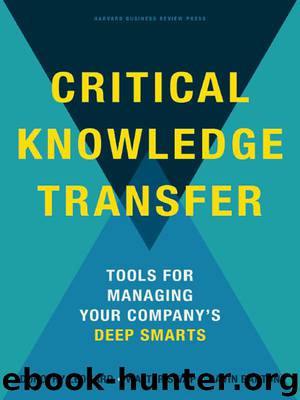Critical Knowledge Transfer: Tools for Managing Your Company's Deep Smarts by Dorothy Leonard & Walter C. Swap & Gavin Barton

Author:Dorothy Leonard & Walter C. Swap & Gavin Barton
Language: eng
Format: mobi
Tags: -
Publisher: Harvard Business Review Press
Published: 2014-11-10T14:00:00+00:00
Communicating the results from knowledge elicitation depends not only on the questioning mode but also on the intended use of the output. Knowledge-elicitation results can be presented either in text, as cognitive maps, or a best-practice process map. Let’s look at an example dealing with risk analysis in a financial services company. In highly regulated industries, risk analysis is not only a critical function, but also an area that calls for a lot of expertise and good judgment.
In this firm, a very experienced employee was retiring, and his colleagues needed to understand how he investigated a possible violation of a federal regulation. What emerged from the interviews (conducted with the colleagues in the room so that they could ask questions) was a behavioral process that looked a lot like a detective procedural or legal thriller—no killers lurking in the bushes, but a lot of evidence gathering and interviewing. The investigator first had to compare the actions of the accused violator with the applicable rule. He had to interview the accused to determine what that individual thought (or claimed) he or she was doing, and why. The employee also consulted with colleagues, seeking their opinions about whether this was a clear violation. He sought data about the violation and the violator: when it happened, whether there were mitigating or aggravating circumstances, and—interestingly, just as in the justice system—whether there was a history of prior similar violations.
His real expertise, however, came in his dogged pursuit of the details that confirmed or confuted the original assumption, made by both him and his colleagues, that a violation had actually taken place. He iterated the cycle of gathering data and collecting testimony until he was certain that he had not neglected to follow up on inconsistencies (figure 5-2). His peers were less tenacious in challenging themselves and others in similar situations. As a consequence, more superficial investigations had sometimes exposed the firm to risk.
Download
This site does not store any files on its server. We only index and link to content provided by other sites. Please contact the content providers to delete copyright contents if any and email us, we'll remove relevant links or contents immediately.
Bad Blood by John Carreyrou(6274)
Rich Dad Poor Dad by Robert T. Kiyosaki(6174)
Principles: Life and Work by Ray Dalio(5957)
Playing to Win_ How Strategy Really Works by A.G. Lafley & Roger L. Martin(5495)
Management Strategies for the Cloud Revolution: How Cloud Computing Is Transforming Business and Why You Can't Afford to Be Left Behind by Charles Babcock(4438)
The Confidence Code by Katty Kay(4036)
Thinking in Bets by Annie Duke(3996)
American Kingpin by Nick Bilton(3507)
Delivering Happiness by Tony Hsieh(3280)
Project Animal Farm: An Accidental Journey into the Secret World of Farming and the Truth About Our Food by Sonia Faruqi(3016)
The Power of Habit by Charles Duhigg(2965)
Brotopia by Emily Chang(2892)
Mastering Bitcoin: Programming the Open Blockchain by Andreas M. Antonopoulos(2891)
The Tyranny of Metrics by Jerry Z. Muller(2846)
I Live in the Future & Here's How It Works by Nick Bilton(2844)
The Marketing Plan Handbook: Develop Big-Picture Marketing Plans for Pennies on the Dollar by Robert W. Bly(2792)
The Content Trap by Bharat Anand(2778)
Building a StoryBrand by Donald Miller(2754)
Applied Empathy by Michael Ventura(2749)
